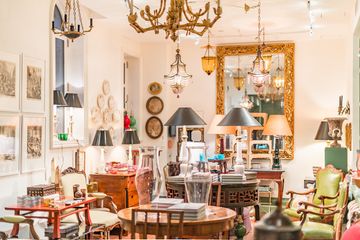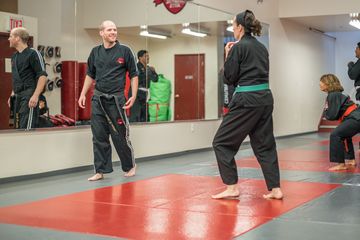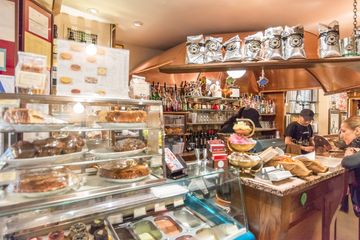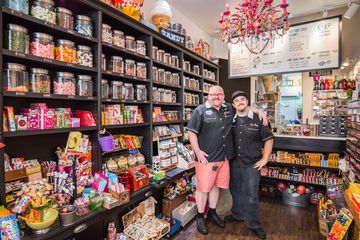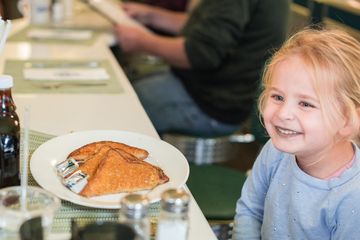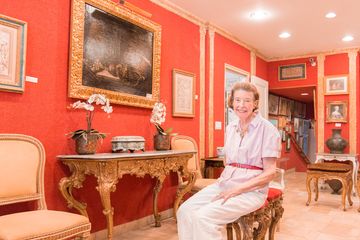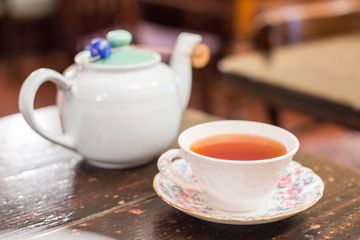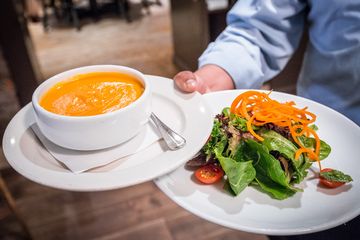"Like a kid in a candy shop" is not an adequate description of how I felt walking into The Sweet Shop. I felt even happier: I was an adult in a candy shop, both dazzled by the color and array of decadent desserts and warmed by the nostalgia brought on by the chocolate cigars and sugar wafers of my childhood. As I watched the flow of customers going in and out of the small store, I realized that I was not alone in my thoughts. All ages come in, with big smiles on their faces, to buy treats from the Candyman, himself. "We're a nostalgic experience, " the Candyman, also known as Kelly Jaime, said when he saw my jaw drop as I walked in the door. Since 2000, Kelly has lived in the neighborhood while working in sales for a Fortune 500 company, and continually lamented that there were no late-night ice cream stores. In 2013, he decided to solve the problem himself. What started as a simple ice cream parlor, however, turned into a place serving candy and ice cream. "The demographic in this area changed overnight, " he explained. "It's much younger – there are strollers everywhere. " With this new kind of audience, Kelly decided to offer all sorts of sweet delicacies rather than ice cream alone. This meant he could sell his favorite treats: marshmallows. "You have to understand this about my dad, " his son piped up. "He loves marshmallows. " The sweet shop is a family-run business. Kelly and his son Matthew, also known as "Pie Guy, " man the store while his wife, Glyn, is the designer behind the Willy Wonka-esque decor. She even made the breath-taking chandelier made of candies and the whimsical sweet-themed cabinet door handles. One of the few things in the space that Glyn created, but did not illustrate, is the little logo of Kelly in his uniform, which they commissioned an artist to do. Despite the fact that Kelly decided not to focus solely on ice cream, he is still very proud of the frozen treats. "We sell five of the top ten ice creams in New York, " he beamed. He pointed out that there is no other location in the city where you can find this many varieties of high quality ice cream in one place. He carries OddFellows and Van Leeuwen standard choices, as well as Van Leeuwen's vegan flavors. He also sells Snowballs, which he describes as, "Better than a snow cone – just smooth, slushified ice. " Even though the whole store is filled with sugar, Kelly says that he is very careful not to feed unhealthy habits. "We are selling small things, " he said. He showed me an example of the tiniest size cone that he fills. They are custom-made by a secret source solely for him, and though he originally meant them for children, they are also bought by many health-conscious adults, counting the nearby medical community among those constituents. Kelly went on to tell me that he buys the highest quality candy and has Underwest Donuts delivered fresh everyday. "We are a fresh fruit stand for candy, " he said with a smile. Moving away from the ice cream counter, Kelly was eager to show off his chocolate collection. He carries a variety, from companies that have been in production since the 1940s to the Mast Brothers, a relatively new chocolatier. He also has a lot of "bean to bar" creations that emphasize the flavor of the cacao bean. When he saw me circling around, questioning where the Reese's Peanut Butter Cups were, Kelly quickly responded, "I don't sell anything that one can find in Duane Reade. " Instead, The Sweet Shop has a private company that makes their amazing peanut butter cups. Next Kelly had me walk over to the drawers upon drawers of Swedish candy. "This candy is just utterly, utterly delicious, " Kelly exclaimed, filling up a bag for each of us from Manhattan Sideways. Next, Kelly gushed over his world famous butter crunch, saying that it has now been shipped to every continent, including Antarctica. And, of course, marshmallows can be found throughout the store, both on their own and in treats like the "Jakewich, " a marshmallow wedged between two Tate's chocolate chip cookies. Though the store is packed with candy, part of the treat of visiting the Sweet Shop is simply talking with the Candyman. Kelly is full of witticisms and stories. I overheard him telling a customer that the licorice was "black like my heart and just as delicious. " He told me that a lot of his whimsical attitude is thanks to his grandmother, who worked with Walt Disney. When Kelly visited her as a child, she would throw him in the Magic Shop whenever she needed a babysitter. There is a small section of the Sweet Shop that acts as an ode to these childhood memories: Kelly pulled out a drawer at the bottom of the Swedish candy that was filled with vintage magic tricks, pranks, and fake candy. Not only that, but there are plastic ninjas and little optical treasures hidden around the room. Recognizing that every inch of space has an element of fun, I learned from Kelly that he had worked in an amusement park in his youth, and was greatly influenced by the excitement of entertainment. When I inquired as to what might be next, this clever, warm man confided that he was about to launch his own chocolate bar line. The flavors were still a secret, but he seemed very excited. "I've been extremely happy with what we've been able to accomplish in two years, " he said enthusiastically. There is no doubt that Kelly has managed to feature an outstanding variety for those of us with a sweet tooth. As we were leaving, Kelly's last words were, "Our family is trying to bring the best confectionary treats, by brand, into one place" From what each of us witnessed and tasted, we would have to agree that he has succeeded.

